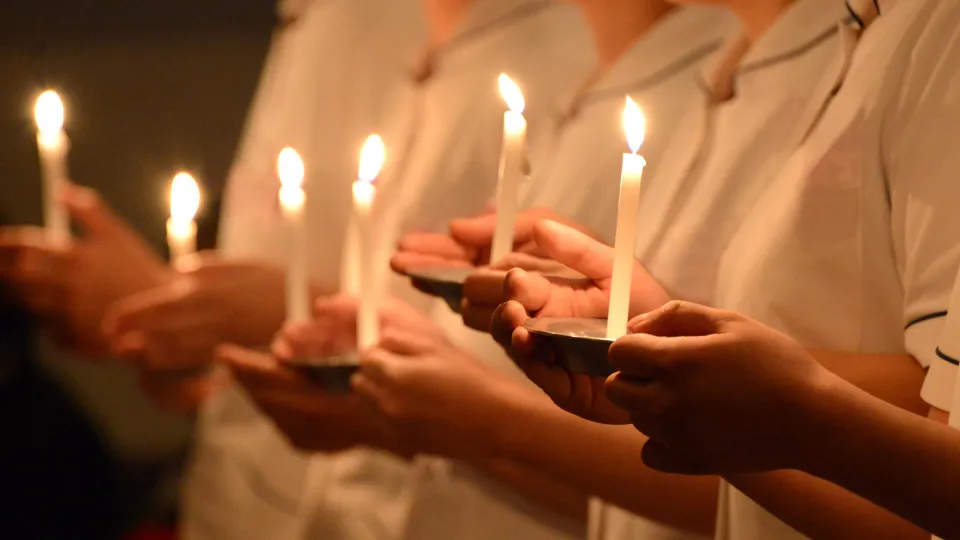
When delving into the meaning of nursing school capping and pinning ceremonies, it may be a good idea first to describe what they are not. As the American Association of Colleges of Nursing explains, capping and pinning ceremonies are not graduations. They do not recognize the distinction between someone who meets all the criteria to earn a degree and someone who does not.
History and Significance of the Pinning Ceremony
The Earliest Nursing Pin: The Maltese Cross
The ceremony is rich with symbolism, and the history goes all the way back to the Crusades of the 12th century. The Knights of the Order of the Hospital of St. John the Baptist tended to the injured and infirm Crusaders. When initiating new monks into the order, the monks vowed to serve these sick soldiers in a ceremony, with each being given a Maltese cross. This was the first badge awarded to those who nurse.
Florence Nightingale and the Red Cross

Looking for a 2-Year Nursing Program Near You?
The modern ceremony dates back to 1855 when Florence Nightingale was awarded the Red Cross of St. George by Queen Victoria in recognition of her tireless service to the injured during the Crimean War. She, in turn, presented a medal of excellence to her brightest graduates. By 1916, the practice of pinning new graduates with an associate degree in nursing was standard throughout the U.S.
What Is the Purpose of Nursing Pins?
Florence Nightingale spent her nightly rounds giving personal care to the wounded. The soldiers would see her lamp approaching in the distance, giving them hope. Nursing graduates receive a nursing lapel pin signifying that they continue to carry on the tradition of providing care to the ill and infirm. The Florence Nightingale Award is presented to the nursing student who demonstrates the characteristics that most exemplify the spirit and skill of the "Lady with the Lamp." Prior to closing the ceremony, the graduates recite the Nightingale pledge.
The Pinning Ceremony Program
While pinning and capping ceremonies are held separately from graduation ceremonies, nursing students usually invite their friends and family to both events. Whether you're attending an upcoming pinning ceremony for yourself or a loved one, here are a few things you may expect to help you prepare for the program.
Order of Events
The order of events for a nurse pinning ceremony may vary from one school to the next, but there are some standard elements that typically make up this event. The basic structure of a pinning ceremony often includes:
- Opening remarks: During the opening remarks, the dean or director of the school addresses the audience and welcomes them to the pinning ceremony.
- Student speaker: At least one standout nursing student may have the honor of speaking during the pinning ceremony to share what this celebratory event symbolizes.
- Faculty speakers: One or two faculty members may also highlight their experience working with the cohort of nursing students and share advice to help them find success as health care professionals.
- The meaning of the pin: At this point in the pinning ceremony program, the nursing school's dean or director usually explains the pin's significance and provides an overview of its rich history.
- The pinning of nursing students: During the pinning, students line up alphabetically and walk across the stage when their names are called to receive their pins.
- The Nightingale pledge: After each student receives their pin, they recite the Nightingale pledge, which is a modified version of the Hippocratic oath that nurses uphold.
- Candle or lamp lighting: Some schools may provide students with candles that symbolize the "Lady of the Lamp," Florence Nightingale, and their commitment to care for the sick and wounded.
- Honorary speaker: Toward the end of the pinning ceremony, a well-known or influential member of the medical community may give a short speech to inspire students as they prepare for their nursing careers.
- Closing remarks: To complete the pinning ceremony, the dean or director of the school usually thanks everyone for attending, and the newly pinned nursing students exit while the audience applauds and congratulates them.
The Pinning Process
When each student hears their name called, they walk across the stage to receive their nursing pin, which a faculty member usually places on the lapel of their white coat. Sometimes, students choose a mentor or loved one to accompany them on stage during the pinning process, making this a special moment for all involved. If the school allows, students may have the person accompanying them place their nursing pin instead of a faculty member. In exchange, the student may dedicate their nursing practice to this individual.
What Happens After the Pinning Ceremony?

What Are the Types of Nursing Careers?
After the ceremony, nursing students may gather with their friends, family members, and loved ones to celebrate and exchange small gifts. A reception may follow, allowing nursing students to mingle with their colleagues and discuss their upcoming graduation ceremony. These events often take place just a few weeks apart from one another.
If you're interested in training for a nursing career, you can experience the pinning and capping ceremonies for yourself after completing one of our nursing programs. Concorde offers pre-licensure and RN to BSN programs to give you the experience and knowledge you need for success in the health care field. Request more information to get started.
"Implementation Guide for Nursing Ceremonies," American Association of Colleges of Nursing, https://www.aacnnursing.org/5b-tool-kit/implementation-nursing-ceremony
"About the Royal Red Cross," UK Parliament, https://www.parliament.uk/about/living-heritage/building/cultural-collections/medals/collection/royal-red-cross/history/
Take The Next Step Towards a Brighter Future
Interested in learning more about our Nursing (Pre-Licensure) program?
We have a Concorde representative ready to talk about what matters most to you. Get answers about start dates, curriculum, financial aid, scholarships and more!







